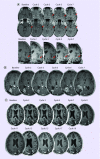An early feasibility study of the Nativis Voyager® device in patients with recurrent glioblastoma: first cohort in US
- PMID: 30547676
- PMCID: PMC6499016
- DOI: 10.2217/cns-2018-0013
An early feasibility study of the Nativis Voyager® device in patients with recurrent glioblastoma: first cohort in US
Abstract
Aim: Evaluation of the Nativis Voyager® device in patients with recurrent glioblastoma (rGBM).
Materials & methods: Voyager is a noninvasive, nonthermal, nonionizing and portable investigational device which delivers ultra-low radio frequency energy (ulRFE®) that uses a magnetic field to penetrate tissues to alter specific biologic functions within cells. Patients with rGBM were treated with Voyager alone (V) or Voyager in combination with standard of care (V + SoC). Safety and clinical utility were assessed every 2-4 months.
Results: Data from the first 11 patients treated are reported here. Median progression-free survival was 10 weeks in the V arm and 16 weeks in the V + SoC arm. Median overall survival was 16 months in V arm and 11 months in the V + SoC arm. No serious adverse events associated with the device were reported.
Conclusion: These data suggest that the Voyager is safe and feasible for the treatment of rGBM.
Keywords: clinical trials; medical device; novel therapy; recurrent GBM; ultra-low radiofrequency energy; brain tumor.
Conflict of interest statement
This study was funded by Nativis, Inc. Portions of the data were presented at the 2017 Society for Neuro-oncology Annual Meeting in San Francisco, CA, USA. C Cobbs and S Kesari are members of the Nativis Scientific Advisory Board. The authors have no other relevant affiliations or financial involvement with any organization or entity with a financial interest in or financial conflict with the subject matter or materials discussed in the manuscript apart from those disclosed.
No writing assistance was utilized in the production of this manuscript.
Figures



Comment in
-
How far will the Voyager® take us?CNS Oncol. 2019 Mar;8(1):CNS26. doi: 10.2217/cns-2018-0019. Epub 2019 Feb 15. CNS Oncol. 2019. PMID: 30767555 Free PMC article. No abstract available.
References
-
- Louis DN, Perry A, Reifenberger G, et al. The 2016 World Health Organization classification of tumors of the central nervous system: a summary. Acta Neuropathol. 2016;131(6):803–820. - PubMed
Publication types
MeSH terms
LinkOut - more resources
Full Text Sources
Other Literature Sources
Medical
